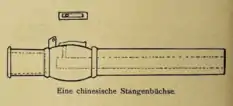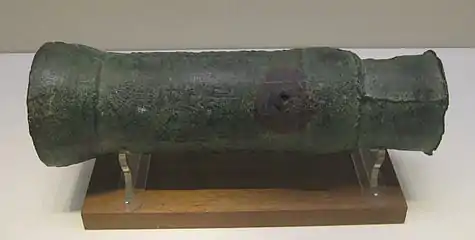Huochong
Huochong (simplified Chinese: 火铳; traditional Chinese: 火銃) was the Chinese name for hand cannons.[1] The oldest confirmed metal huochong, also the first cannon, is a bronze hand cannon bearing an inscription dating it to 1298 (see Xanadu gun).[2]

Hand cannon from the Chinese Yuan Dynasty (1271-1368)
By the time of the Ming Dynasty (1368–1644) two types of huochong were in use. One was a hand held version with a wooden shaft known as a shouchong (手铳) whilst the larger Wankouchong (碗口铳 - bowl-mouthed cannon) or Zhankouchong (盏口铳 - cup-mouthed cannon)[3] rested on a supporting wooden frame.[4] It was invented presumably as an advance in warfare, a new way to fight.
Gallery
 Drawing of a Chinese pole gun found in Java, 1421. It weighed 2.252 kg, length of 357 mm, and caliber of 16 mm. This gun features a rain cover connected with hinge, which is now missing. The hinge is still preserved.
Drawing of a Chinese pole gun found in Java, 1421. It weighed 2.252 kg, length of 357 mm, and caliber of 16 mm. This gun features a rain cover connected with hinge, which is now missing. The hinge is still preserved._MET_DT366859.jpg.webp) Chinese hand cannon (Chong), dated 1424. Length 35.7 cm, caliber 15 mm, weight 2.2736 kg.
Chinese hand cannon (Chong), dated 1424. Length 35.7 cm, caliber 15 mm, weight 2.2736 kg. A socketed Ming hand cannon, 1505.
A socketed Ming hand cannon, 1505. Bronze cannon with inscription dated the 3rd year of the Zhiyuan era (1332) of the Yuan Dynasty (1271-1368); it was discovered at the Yunju Temple of Fangshan District, Beijing in 1935. It is similar to Xanadu gun.
Bronze cannon with inscription dated the 3rd year of the Zhiyuan era (1332) of the Yuan Dynasty (1271-1368); it was discovered at the Yunju Temple of Fangshan District, Beijing in 1935. It is similar to Xanadu gun.
See also
- Hu dun pao, a term refers to trebuchet and cannon.
- Heilongjiang hand cannon, hand cannon, ca. 1287-1288.
- Xanadu gun, a bowl-mouthed cannon, 1298.
- Wuwei Bronze Cannon, late Western Xia (1214-1227).
- Gunpowder weapons in the Song dynasty
- Military of the Yuan dynasty
- Bedil tombak, Nusantaran hand cannon.
References
- "Chinese Military Technology and Dai Viet: c. 1390-1497" (PDF). September 2003. Archived from the original (PDF) on September 20, 2010. Retrieved November 18, 2010.
- "The World's Earliest Cannon (世界上最早的火炮)" (in Chinese). Archived from the original on July 23, 2011. Retrieved November 18, 2010.
- Aung-Thwin, Michael Arthur (2011). New Perspectives on the History and Historiography of Southeast Asia: Continuing Explorations. Routledge. p. 83. ISBN 9781136819643.
- History of Ming Army Records Chapter Four
This article is issued from Wikipedia. The text is licensed under Creative Commons - Attribution - Sharealike. Additional terms may apply for the media files.